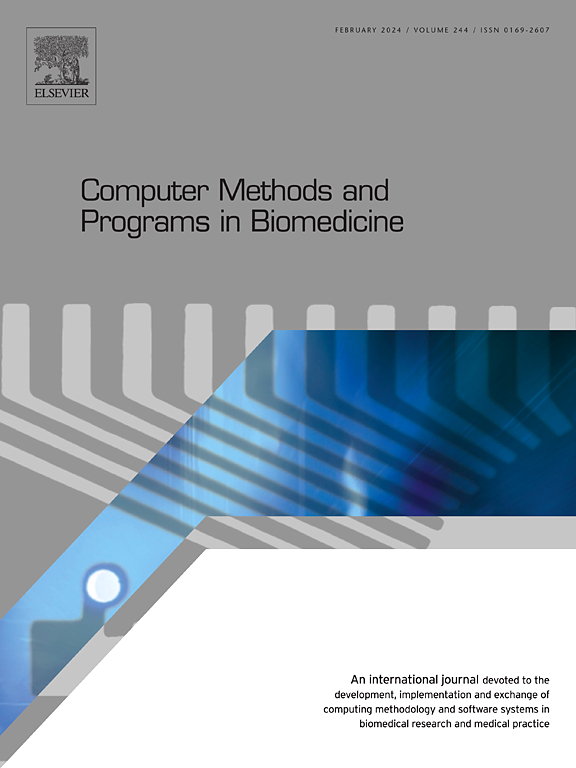Targeted drug delivery to the deviated regions of the human nasal cavities: An in silico investigation and in vitro validation
IF 4.9
2区 医学
Q1 COMPUTER SCIENCE, INTERDISCIPLINARY APPLICATIONS
引用次数: 0
Abstract
Background and Objective
Delivering drugs to the deviated regions in patients with nasal septal deviation is vital for the treatment but challenging due to the complex shape of the nasal cavity and the intersubject variability in the nasal anatomies. While previous studies have focused on drug delivery to standard areas like the olfactory region, none have specifically looked at how drugs are deposited in the deviated regions. The current study numerically investigates six drug administration parameters aiming to control and maximize drug deposition in the deviated regions of the nasal cavity in three types of septal deviations.
Methods
Three-dimensional models are created using CT scans from three patients, with S-shaped, C-shaped, and reverse C-shaped septal deviations, and the deviated regions are identified by the detailed slice-by-slice inspection method. Eulerian and Lagrangian simulations are performed for the fluid flow and drug delivery, incorporating all six drug administration parameter variations. Further, in-house experiments are performed on a three-dimensional printed transparent nasal cavity to validate the pressure drop and drug deposition patterns.
Results
It is observed that increasing the spray half-cone angle decreases the targeted deposition in the C, reverse C, and left side of the S-shaped models. On the contrary, a wider half-cone angle (20°) and cone radius (2 mm) enhances targeted deposition on the right side of the S-shaped model. The ideal particle size range for all models is 10 to 16 µm. Lower initial particle velocities (1 m/s and 3 m/s) lead to maximum targeted deposition in the C and left side of the S-shaped models, while higher ones (14 m/s and 8m/s) enhance targeted deposition in the reverse C and right side of the S-shaped model, respectively. Optimized administration angles accurately direct particles to deviated regions, with patient-specific adjustments achieving better outcomes. Increased flow rates enhance both total and targeted depositions. Head orientation adjustments are effective for deviations in the middle and lower regions but have a limited impact when deviation presents in the anterior regions.
Conclusions
The study's findings help unveil the effective targeted drug delivery strategies, provide insights for the better design of the nasal spray device, and improve personalized treatment efficacy for patients with septal deviations.

人类鼻腔偏离区域的靶向药物递送:计算机研究和体外验证
背景与目的将药物输送到鼻中隔偏曲患者的偏曲区域对于治疗至关重要,但由于鼻腔的复杂形状和主体间鼻腔解剖结构的可变性,这具有挑战性。虽然以前的研究主要集中在药物输送到标准区域,如嗅觉区域,但没有人专门研究药物是如何在偏离区域沉积的。本研究通过数值研究六个给药参数,旨在控制和最大化药物在三种类型鼻中隔偏差的鼻腔偏移区域的沉积。方法对3例s型、c型和反c型鼻中隔偏离患者进行CT扫描,建立三维模型,并通过详细的逐层检查方法识别偏离区域。欧拉和拉格朗日模拟了流体流动和药物输送,包括所有六个给药参数的变化。此外,在三维打印透明鼻腔上进行了内部实验,以验证压降和药物沉积模式。结果增大喷雾半锥角会降低s型模型的C、反C和左侧的靶沉积。相反,更宽的半锥角(20°)和锥半径(2mm)增强了s型模型右侧的定向沉积。所有型号的理想粒径范围为10至16 μ m。较低的初始粒子速度(1 m/s和3 m/s)在s型模型的C区和左侧靶向沉积最大,而较高的初始粒子速度(14 m/s和8m/s)分别增强了s型模型的反C区和右侧靶向沉积。优化的管理角度准确地直接颗粒到偏离区域,与患者特定的调整实现更好的结果。流速的增加增加了总沉积量和目标沉积量。头部定向调整对中下侧区域的偏差有效,但对前侧区域的偏差影响有限。结论本研究结果有助于揭示有效的靶向给药策略,为更好地设计鼻喷雾器提供见解,提高鼻中隔偏曲患者的个性化治疗效果。
本文章由计算机程序翻译,如有差异,请以英文原文为准。
求助全文
约1分钟内获得全文
求助全文
来源期刊

Computer methods and programs in biomedicine
工程技术-工程:生物医学
CiteScore
12.30
自引率
6.60%
发文量
601
审稿时长
135 days
期刊介绍:
To encourage the development of formal computing methods, and their application in biomedical research and medical practice, by illustration of fundamental principles in biomedical informatics research; to stimulate basic research into application software design; to report the state of research of biomedical information processing projects; to report new computer methodologies applied in biomedical areas; the eventual distribution of demonstrable software to avoid duplication of effort; to provide a forum for discussion and improvement of existing software; to optimize contact between national organizations and regional user groups by promoting an international exchange of information on formal methods, standards and software in biomedicine.
Computer Methods and Programs in Biomedicine covers computing methodology and software systems derived from computing science for implementation in all aspects of biomedical research and medical practice. It is designed to serve: biochemists; biologists; geneticists; immunologists; neuroscientists; pharmacologists; toxicologists; clinicians; epidemiologists; psychiatrists; psychologists; cardiologists; chemists; (radio)physicists; computer scientists; programmers and systems analysts; biomedical, clinical, electrical and other engineers; teachers of medical informatics and users of educational software.
 求助内容:
求助内容: 应助结果提醒方式:
应助结果提醒方式:


